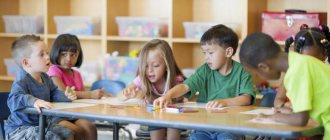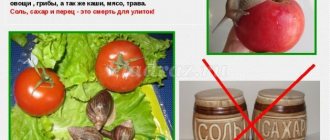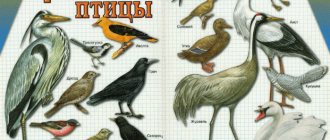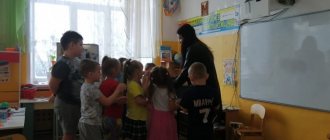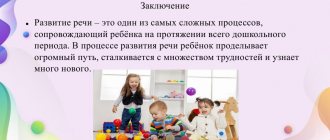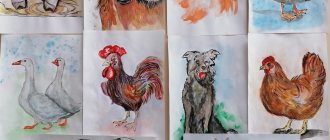Summary of educational activities for the development of speech “City - Village”
Summary of educational activities for the development of speech “City - Village”
Jerina I.B.
Summary of educational activities for the development of speech “City - Village”
Content of organized educational activities.
Goals: to give children an idea of what a city and a village
, What is the difference;
give children knowledge about the peculiarities of work in the city and village
. To instill in children a feeling of love for their Motherland - Russia.
Develop memory in children
, logical thinking, visual attention and perception.
Strengthen children's coherent speech
, formation of the grammatical structure
of speech
,
developing the sound culture of speech
, enriching vocabulary.
Developmental environment
: paintings depicting rural and
urban landscapes
;
handout subject pictures depicting objects related to the city and village
(multi-story building, buses, trolleybuses, underground passage, one-story houses, combine harvester, tractor, pets, etc.). Simple pencils, notebooks for graphic writing in large squares.
Organizing time.
The teacher invites the children to look at two paintings depicting an urban and rural landscape
.
Questions for children: 1. What do you see in the paintings? 2. Which picture shows the city
?
3. Which picture shows a village or a village
?
4. Do you think we live in a city or a village
? 5. Why did you decide this? 6. Which of you was in the village? Tell us what kind of houses there were in your village. What was the transport like? Children's answers.
Didactic game “Say it differently”
. Goal: to teach children to form adjectives from nouns. Progress of the game: children must say the phrase spoken by the teacher differently.
Lexical material.
Man living in the city
, (what...
( urban )
.
A person living in a village (what... (village)
.
Village resident (what... (rural)
.
Post office located in the village (what... (village office)
.
Shop in the village (what... (rural)
.
Didactic game “And here, in the village”
.
Goal: to teach children to form words using diminutive suffixes - k -, - chk -, - enk -, - ok -, - ik -. Progress of the game: the children are offered a short story: “A grandmother came to visit us from the village. She walked around the big city and was amazed at
big the houses
are in our .” The teacher invites the children to say the words spoken to them affectionately, as the kind grandmother calls them.
Lexical material.
A village is a village.
Street - street.
City - town
.
Prospect - prospectus.
A house is a house.
Didactic game “Finish the phrase”
. Goal: to teach children to form masculine, feminine, neuter singular and plural nouns in the genitive case. Progress of the game: the teacher invites the children to finish the phrase he started:
Grandma has one square in the village, but in the city there are many... (squares)
.
Grandmother has one street in the village, but in the city there are many... (streets)
.
My grandmother has one church in the village, but in the city there are many... (churches)
.
Grandmother has one store in the village, and in the city there are many ... (shops)
.
My grandmother has one museum in the village, but in the city there are many... (museums)
.
The teacher tells the children about what is happening in the city
, and people work in the village.
The teacher draws the children's attention to the pictures and invites the children to tell where people work - in the city or the village
?
(In one picture, cows are being milked, and in the other, workers are standing at the machines)
. Children's answers.
The teacher continues his story; “ There are many factories in the city
, factories where people make cars, books, toys and much more.
There are enterprises
in where they make cheese, cottage cheese, kefir, sour cream, yogurt, and butter.
All this is made from milk. Where do they get milk? That's right, in the village, in the village. There people raise livestock, milk cows, and bring milk to the city
, and you and I can buy products made from milk in the store.
There are many factories in
where bread is baked. Where do they get flour for bread? Yes, in the village they grow wheat and rye, from which they then make flour.
In the village, they grow vegetables in the fields, and in the gardens they grow very healthy and tasty fruits, which we love very much and often buy in stores in the city.
.
But to grow and harvest crops, you need different equipment - tractors, combines.
Where will rural workers get them from? That's right, all the equipment is made by workers in the city
.
This is how city and village
.
(The teacher accompanies his entire story by showing illustrations)
.
Dynamic pause. Finger exercise “House and gates”
.
There is a house in a clearing ( "House"
draw with two hands, the roof of a house - the fingers of the left and right hands touch each other).
Well, the path to the house is closed. (The right and left hands are turned with palms facing each other, the middle fingers touch each other, the thumbs point up ( “gate”
).
We open the gates, (Palms turn parallel to each other)
.
We invite you to this house. ( "House"
).
Didactic game " City - Village "
.
Children place on the board under the large picture - small ones on which the image relates to the city and explain
why they think so. Then the children find pictures related to the village.
Graphic letter “Complete the house according to the model”
.
In large-checked notebooks, children draw a village one-story house and a city multi-story house
.
Reflection.
The lesson is summarized. Children talk about how people in our country live in cities
, villages, hamlets.
The city
has many streets with multi-storey buildings, a lot of different types of transport, people work in factories and factories.
In villages and villages there are few streets, the houses are not multi-story, and there is little transport. People grow wheat, rye, various vegetables, fruits, and care for various domestic animals. People in the city
and villages help each other.
The teacher gives the children a task: to learn their home address with their parents. See what new and good things have appeared near their house for the convenience of people (they paved the paths, painted the buildings in the yard, planted trees, repaired the entrance, etc.).
Summary of a lesson on speech development in the senior group of kindergarten on the topic “Hometown”
Summary of organized educational activities for the development of speech “City”
Goal: Development of grammatically correct speech and speech creativity while consolidating knowledge about the hometown. Objectives: 1. Expand children’s ideas about their hometown, introduce them to some of its attractions. 2. Learn to answer questions in complete sentences, teach children to select words and signs. Activate children's vocabulary. 3. Develop children’s coherent speech, teach children to tell stories based on graphic symbols, using mnemonics. 4. Develop children's memory, thinking, and hand motor skills. 5. Develop skills of cooperation, initiative and independence. 6. Cultivate a love for your hometown and a sense of pride in it, a desire to make it even more beautiful. Materials and equipment: a doll with wings, a ball, a bag of pebbles, puzzles (shop, water park, pharmacy, train station), cards with geometric shapes, mnemonic tables), audio recording “If life is fun.” Preliminary work: Conversation “Our city”, examination of illustrations “Sights of the city”, observation “What is there near the kindergarten”.
Progress of the lesson
Motivational stage Educator: Let’s stand side by side, in a circle, Say “Hello!” each other. We are not too lazy to say hello: “Hello!” to everyone! and “Good afternoon!”; If everyone smiles, a good morning will begin. - GOOD MORNING! Educator: Guys, this morning I went out onto the balcony to see what the weather was like outside and saw a guest. She was sitting on a chair, there was snow on her wings, she was even a little cold. Who do you think it could be? (Children's answers) Educator: I invited her to kindergarten with me. Sit down on the cushions, I'll bring it now. (I take out the doll) Educator: These guys are the fairy Eya, she traveled through the cities and ended up in our beautiful city to get to know it and its inhabitants. (the doll flies around the children, the children say hello) Main stage Educator: Boys and girls, Eya was recently in Moscow, and what city do we live in? Children: Tyumen Educator: What can you call the people who live in our city? Children: Tyumen residents Educator: You and I are Tyumen residents, we are already familiar with our city. Eya also wants to see our beautiful city. What kind of city is ours? Children: beautiful, big, clean, cozy, huge. Educator: There are many streets in our city, and Eya needs to be introduced to them. Ball game “I live on the street...” Educator: What street is our kindergarten located on? Children: Installers. Educator: Look, you have cards under your pillows, count how many geometric shapes there are. Go to the table with the same figures and a number indicating the quantity. Puzzle game “What is there in the city” Educator: What did you get? What is there in our city? Educator: Do the residents of our city like to have fun? Children: Yes Educator: Let's have some fun Warm-up (If life is fun) Educator: Now I propose to tell Eya and our guests about our city. A table will help us. Look carefully, think about what you will talk about. There is a theater in our city. It is located on Republic Street. The theater employs actors, directors, and costume designers. You need to follow the rules, don’t make noise, don’t leave trash. I love watching performances. (circus, shop, embankment) Final stage Educator: That's how much we told about places in our city. Eya thanks you, she has a gift for you, a magic bag. Educator: These beautiful stones are for you, they will fulfill your wishes. Questions when receiving a pebble - What are the people of our city called? — What streets are there in our city? — Where do you like to walk in our city? — What places did we tell Eya about? — Where should Ei fly on the weekend? — What transport can you use to travel in our city? Educator: Thank you guys so much, my new friend and I will go for a walk tomorrow. You can also walk around the city with your parents and send us photos. Or you can even have a video in which you tell about the place you will be near.
We recommend watching:
Lesson on speech development and familiarization with the environment in the senior group. Summary of a lesson on speech development for children in the senior group. Topic: “How winter meets spring” Summary of a lesson on speech development for older preschoolers Summary of a lesson on speech development in the senior group for children with a stutter: Winter fun
Similar articles:
Summary of a lesson on speech development in the senior group. Retelling of a work of art. Ushinsky “Medicine”
Summary of a lesson on speech development in the senior group. Funny riddles
Lesson notes on speech development in the senior group
Lesson summary on the topic “Relationships in the family.” Senior group
Lesson on emotional development in the senior group
